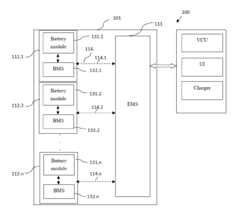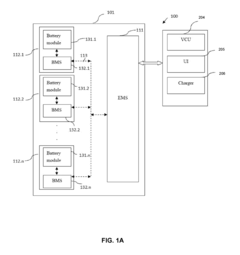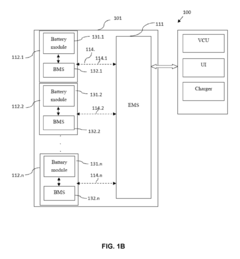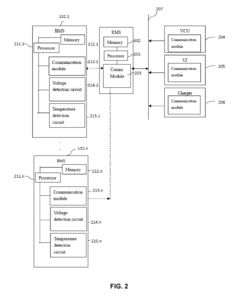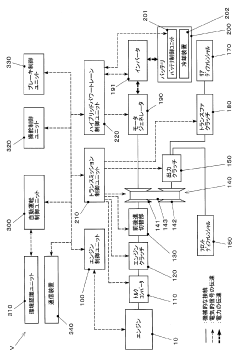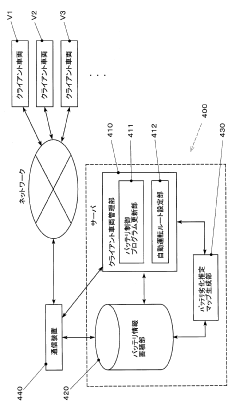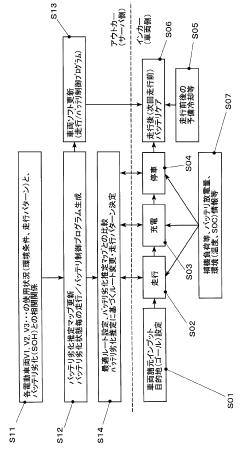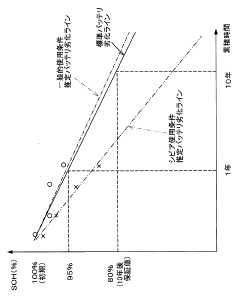The Role of Battery Management Systems in Electric Public Transportation
AUG 8, 20259 MIN READ
Generate Your Research Report Instantly with AI Agent
Patsnap Eureka helps you evaluate technical feasibility & market potential.
BMS Evolution in E-Transit
Battery Management Systems (BMS) have undergone significant evolution in the context of electric public transportation. The journey of BMS in e-transit began with rudimentary systems focused primarily on basic battery protection and simple charge control. These early systems lacked sophistication and often resulted in suboptimal battery performance and reduced lifespan.
As electric public transportation gained traction, the demands on BMS increased exponentially. The need for more efficient energy utilization, longer vehicle range, and improved safety drove rapid advancements in BMS technology. This led to the development of more sophisticated systems capable of real-time monitoring and management of individual battery cells.
The next phase of evolution saw the integration of advanced algorithms and predictive analytics into BMS. These systems could now anticipate potential issues, optimize charging cycles, and extend battery life through intelligent management strategies. This marked a significant leap forward in the reliability and efficiency of electric public transportation.
With the advent of connected and smart city technologies, BMS in e-transit entered a new era of data-driven optimization. These systems began leveraging big data and cloud computing to analyze vast amounts of operational data, enabling fleet-wide energy management and predictive maintenance.
Recent developments have focused on enhancing the interoperability of BMS with other vehicle systems and charging infrastructure. This has led to the creation of holistic energy management ecosystems that optimize not just the vehicle's performance but also its interaction with the broader transportation network and power grid.
The latest frontier in BMS evolution for e-transit involves the integration of artificial intelligence and machine learning. These technologies enable BMS to continuously learn and adapt to changing conditions, driver behaviors, and route characteristics, further optimizing energy usage and extending vehicle range.
Looking ahead, the evolution of BMS in electric public transportation is expected to continue at a rapid pace. Future systems will likely incorporate more advanced sensors, faster processing capabilities, and even more sophisticated AI algorithms. This ongoing evolution will play a crucial role in making electric public transportation more efficient, reliable, and sustainable, ultimately contributing to the broader goals of urban mobility and environmental sustainability.
As electric public transportation gained traction, the demands on BMS increased exponentially. The need for more efficient energy utilization, longer vehicle range, and improved safety drove rapid advancements in BMS technology. This led to the development of more sophisticated systems capable of real-time monitoring and management of individual battery cells.
The next phase of evolution saw the integration of advanced algorithms and predictive analytics into BMS. These systems could now anticipate potential issues, optimize charging cycles, and extend battery life through intelligent management strategies. This marked a significant leap forward in the reliability and efficiency of electric public transportation.
With the advent of connected and smart city technologies, BMS in e-transit entered a new era of data-driven optimization. These systems began leveraging big data and cloud computing to analyze vast amounts of operational data, enabling fleet-wide energy management and predictive maintenance.
Recent developments have focused on enhancing the interoperability of BMS with other vehicle systems and charging infrastructure. This has led to the creation of holistic energy management ecosystems that optimize not just the vehicle's performance but also its interaction with the broader transportation network and power grid.
The latest frontier in BMS evolution for e-transit involves the integration of artificial intelligence and machine learning. These technologies enable BMS to continuously learn and adapt to changing conditions, driver behaviors, and route characteristics, further optimizing energy usage and extending vehicle range.
Looking ahead, the evolution of BMS in electric public transportation is expected to continue at a rapid pace. Future systems will likely incorporate more advanced sensors, faster processing capabilities, and even more sophisticated AI algorithms. This ongoing evolution will play a crucial role in making electric public transportation more efficient, reliable, and sustainable, ultimately contributing to the broader goals of urban mobility and environmental sustainability.
E-Bus Market Dynamics
The electric bus (e-bus) market has experienced significant growth in recent years, driven by increasing environmental concerns, government regulations, and advancements in battery technology. This surge in demand for e-buses has created a dynamic and rapidly evolving market landscape, with implications for both public transportation systems and the broader automotive industry.
One of the key factors propelling the e-bus market is the global push for sustainable transportation solutions. Cities worldwide are setting ambitious targets to reduce carbon emissions and improve air quality, leading to a shift away from traditional diesel-powered buses towards electric alternatives. This transition is further supported by government incentives and regulations that promote the adoption of zero-emission vehicles in public transportation fleets.
The market dynamics of e-buses are closely tied to advancements in battery technology. As battery costs continue to decrease and energy density improves, the total cost of ownership for e-buses is becoming increasingly competitive with conventional buses. This trend is expected to accelerate in the coming years, making e-buses an increasingly attractive option for transit agencies and operators.
The e-bus market is characterized by a diverse range of players, including traditional bus manufacturers, new entrants specializing in electric vehicles, and technology companies focusing on battery and charging solutions. This competitive landscape is driving innovation and pushing the boundaries of e-bus performance, range, and efficiency.
Regional variations play a significant role in shaping the e-bus market dynamics. China has emerged as the global leader in e-bus adoption, with its cities accounting for the majority of the world's electric bus fleet. However, other regions, including Europe and North America, are rapidly catching up, with ambitious plans to electrify their public transportation systems.
The growth of the e-bus market is also influencing the development of charging infrastructure. As more e-buses are deployed, there is an increasing need for efficient and reliable charging solutions, including depot charging, opportunity charging, and even wireless charging technologies. This has created new opportunities for companies specializing in charging infrastructure and grid management solutions.
The role of Battery Management Systems (BMS) is becoming increasingly critical in the e-bus market. As the heart of an electric bus's power system, BMS technology directly impacts vehicle performance, range, and longevity. Advanced BMS solutions are enabling more efficient energy utilization, faster charging times, and improved battery life, all of which contribute to the overall value proposition of e-buses.
One of the key factors propelling the e-bus market is the global push for sustainable transportation solutions. Cities worldwide are setting ambitious targets to reduce carbon emissions and improve air quality, leading to a shift away from traditional diesel-powered buses towards electric alternatives. This transition is further supported by government incentives and regulations that promote the adoption of zero-emission vehicles in public transportation fleets.
The market dynamics of e-buses are closely tied to advancements in battery technology. As battery costs continue to decrease and energy density improves, the total cost of ownership for e-buses is becoming increasingly competitive with conventional buses. This trend is expected to accelerate in the coming years, making e-buses an increasingly attractive option for transit agencies and operators.
The e-bus market is characterized by a diverse range of players, including traditional bus manufacturers, new entrants specializing in electric vehicles, and technology companies focusing on battery and charging solutions. This competitive landscape is driving innovation and pushing the boundaries of e-bus performance, range, and efficiency.
Regional variations play a significant role in shaping the e-bus market dynamics. China has emerged as the global leader in e-bus adoption, with its cities accounting for the majority of the world's electric bus fleet. However, other regions, including Europe and North America, are rapidly catching up, with ambitious plans to electrify their public transportation systems.
The growth of the e-bus market is also influencing the development of charging infrastructure. As more e-buses are deployed, there is an increasing need for efficient and reliable charging solutions, including depot charging, opportunity charging, and even wireless charging technologies. This has created new opportunities for companies specializing in charging infrastructure and grid management solutions.
The role of Battery Management Systems (BMS) is becoming increasingly critical in the e-bus market. As the heart of an electric bus's power system, BMS technology directly impacts vehicle performance, range, and longevity. Advanced BMS solutions are enabling more efficient energy utilization, faster charging times, and improved battery life, all of which contribute to the overall value proposition of e-buses.
BMS Challenges in PT
Battery Management Systems (BMS) in electric public transportation face unique challenges due to the demanding nature of their operational environment. One of the primary challenges is the need for robust thermal management. Public transport vehicles often operate for extended periods, subjecting batteries to high stress and potential overheating. BMS must continuously monitor and regulate battery temperature to prevent thermal runaway and ensure optimal performance across diverse weather conditions.
Another significant challenge is the requirement for rapid charging capabilities. Public transportation schedules demand minimal downtime, necessitating fast-charging solutions. However, rapid charging can lead to increased battery degradation if not properly managed. BMS must balance the need for quick charging with the preservation of battery longevity, implementing sophisticated charging algorithms that adapt to various factors such as battery state of charge, temperature, and vehicle usage patterns.
The high-power demands of public transport vehicles also present a challenge for BMS. Frequent starts and stops, coupled with the need to power auxiliary systems like air conditioning and passenger information displays, require precise power management. BMS must efficiently distribute power while preventing over-discharge or overload of individual cells, which could lead to premature battery failure or safety issues.
Reliability and safety are paramount in public transportation, placing additional pressure on BMS design. The system must be capable of detecting and mitigating potential faults or anomalies in real-time, ensuring passenger safety and uninterrupted service. This includes implementing redundancy measures and fail-safe mechanisms to handle critical situations such as cell imbalances or unexpected voltage fluctuations.
Furthermore, BMS in public transportation must address the challenge of long-term battery health monitoring and predictive maintenance. Given the high cost of battery replacement and the need to maximize vehicle uptime, BMS should incorporate advanced diagnostics and prognostics capabilities. This involves analyzing historical data, current battery performance, and environmental factors to predict potential issues and optimize maintenance schedules.
Interoperability and standardization pose another challenge for BMS in public transportation. With various manufacturers and models of electric buses and trams in operation, BMS must be adaptable to different battery chemistries and vehicle configurations. This requires the development of flexible, modular BMS architectures that can be easily integrated into diverse public transport fleets while maintaining consistent performance and safety standards.
Another significant challenge is the requirement for rapid charging capabilities. Public transportation schedules demand minimal downtime, necessitating fast-charging solutions. However, rapid charging can lead to increased battery degradation if not properly managed. BMS must balance the need for quick charging with the preservation of battery longevity, implementing sophisticated charging algorithms that adapt to various factors such as battery state of charge, temperature, and vehicle usage patterns.
The high-power demands of public transport vehicles also present a challenge for BMS. Frequent starts and stops, coupled with the need to power auxiliary systems like air conditioning and passenger information displays, require precise power management. BMS must efficiently distribute power while preventing over-discharge or overload of individual cells, which could lead to premature battery failure or safety issues.
Reliability and safety are paramount in public transportation, placing additional pressure on BMS design. The system must be capable of detecting and mitigating potential faults or anomalies in real-time, ensuring passenger safety and uninterrupted service. This includes implementing redundancy measures and fail-safe mechanisms to handle critical situations such as cell imbalances or unexpected voltage fluctuations.
Furthermore, BMS in public transportation must address the challenge of long-term battery health monitoring and predictive maintenance. Given the high cost of battery replacement and the need to maximize vehicle uptime, BMS should incorporate advanced diagnostics and prognostics capabilities. This involves analyzing historical data, current battery performance, and environmental factors to predict potential issues and optimize maintenance schedules.
Interoperability and standardization pose another challenge for BMS in public transportation. With various manufacturers and models of electric buses and trams in operation, BMS must be adaptable to different battery chemistries and vehicle configurations. This requires the development of flexible, modular BMS architectures that can be easily integrated into diverse public transport fleets while maintaining consistent performance and safety standards.
Current BMS Solutions
01 Battery monitoring and control systems
These systems monitor various parameters of batteries, such as voltage, current, temperature, and state of charge. They use this information to optimize battery performance, extend battery life, and ensure safe operation. Advanced algorithms are employed to estimate battery health and predict remaining useful life.- Battery monitoring and control systems: These systems monitor various parameters of battery cells or packs, such as voltage, current, temperature, and state of charge. They use this data to optimize battery performance, ensure safe operation, and extend battery life through intelligent charging and discharging strategies.
- Thermal management in battery systems: Thermal management solutions for battery systems focus on maintaining optimal operating temperatures. This includes cooling systems, heat dissipation methods, and temperature regulation strategies to prevent overheating and ensure efficient battery performance across various environmental conditions.
- Battery balancing techniques: Battery balancing techniques aim to equalize the charge levels across multiple cells in a battery pack. This ensures uniform charge distribution, prevents overcharging of individual cells, and extends the overall lifespan of the battery system by maintaining balanced cell voltages.
- State of charge and health estimation: Advanced algorithms and techniques are employed to accurately estimate the state of charge (SoC) and state of health (SoH) of batteries. These estimations are crucial for predicting remaining battery life, optimizing charging cycles, and scheduling maintenance or replacement of battery systems.
- Integration with energy management systems: Battery management systems are increasingly integrated with broader energy management systems, particularly in applications like electric vehicles and smart grids. This integration allows for optimized energy distribution, improved power efficiency, and enhanced coordination between battery systems and other power sources or loads.
02 Thermal management in battery systems
Thermal management is crucial for battery performance and safety. These systems regulate battery temperature through cooling or heating mechanisms, preventing overheating and maintaining optimal operating conditions. They may include temperature sensors, cooling circuits, and control algorithms to manage heat distribution across battery packs.Expand Specific Solutions03 Cell balancing techniques
Cell balancing ensures that all cells in a battery pack maintain similar voltage levels, preventing overcharging or undercharging of individual cells. This can be achieved through passive or active balancing methods, improving overall battery pack performance and longevity.Expand Specific Solutions04 State of charge and state of health estimation
Advanced algorithms are used to accurately estimate the state of charge (SoC) and state of health (SoH) of batteries. These estimations are crucial for optimizing battery usage, predicting remaining range in electric vehicles, and scheduling maintenance. Machine learning techniques may be employed to improve accuracy over time.Expand Specific Solutions05 Integration with power electronics and energy management systems
Battery management systems are often integrated with power electronics and broader energy management systems. This integration allows for optimized charging and discharging strategies, coordination with renewable energy sources, and grid interaction in applications such as electric vehicles and stationary energy storage.Expand Specific Solutions
E-Bus BMS Key Players
The battery management systems (BMS) market for electric public transportation is in a growth phase, driven by increasing adoption of electric buses and trains. The market size is expanding rapidly, with projections indicating significant growth over the next decade. Technologically, BMS solutions are maturing but still evolving, with key players like Samsung SDI, Robert Bosch, and Honda Motor leading innovation. These companies are developing more advanced, efficient, and reliable BMS technologies to address challenges in energy management, safety, and performance optimization for large-scale electric vehicle fleets. Emerging players like Dukosi and EVAR are also contributing novel approaches, indicating a dynamic and competitive landscape in this sector.
Samsung SDI Co., Ltd.
Technical Solution: Samsung SDI has developed a cutting-edge BMS for electric public transportation, leveraging their expertise in battery technology. Their system employs advanced cell balancing techniques to ensure optimal performance and longevity of large-scale battery packs used in buses and trams. Samsung's BMS utilizes machine learning algorithms for accurate prediction of battery degradation and remaining useful life, crucial for planning maintenance and replacement schedules in public transport fleets[9]. The company has also implemented a modular BMS architecture, allowing for easy scalability and adaptation to various vehicle sizes and battery configurations. Samsung's system includes robust safety features, such as multi-level fault detection and isolation protocols, essential for ensuring passenger safety in public transportation. Additionally, their BMS incorporates fast charging capabilities, optimizing the charging process to minimize downtime while preserving battery health[10].
Strengths: Extensive battery expertise, advanced predictive algorithms, and modular scalable design. Weaknesses: May have less experience in overall vehicle system integration compared to traditional automotive manufacturers.
Robert Bosch GmbH
Technical Solution: Bosch has developed advanced Battery Management Systems (BMS) for electric public transportation. Their system utilizes intelligent cell monitoring and balancing techniques to optimize battery performance and longevity. The BMS employs predictive analytics to forecast battery health and maintenance needs, reducing downtime for public transport vehicles[1]. Bosch's solution integrates with the vehicle's overall energy management system, allowing for efficient power distribution and regenerative braking optimization. The company has also implemented wireless BMS technology, reducing wiring complexity and weight in large battery packs typically used in buses and trams[2].
Strengths: Extensive experience in automotive systems, advanced predictive analytics, and wireless BMS technology. Weaknesses: Potentially higher cost compared to simpler systems, may require specialized training for maintenance personnel.
BMS Core Innovations
Power management in electric vehicles
PatentActiveUS20170158059A1
Innovation
- A power management system for electric vehicles that employs a master-slave wireless communication architecture, using a single or multiple wireless frequency channels for data communication between an energy management system and battery management systems, allowing for efficient monitoring and management of battery modules with reduced wiring and improved module replacement convenience.
Battery management system for electric vehicle and electric vehicle
PatentActiveJP2022059540A
Innovation
- A battery management system that utilizes a network of electric vehicles to share deterioration and usage data, enabling accurate estimation of battery health and future deterioration, and adjusts vehicle control strategies to mitigate battery degradation through route optimization and power management.
BMS Safety Standards
Battery Management Systems (BMS) in electric public transportation must adhere to stringent safety standards to ensure the reliability and safety of these vehicles. These standards are crucial for protecting passengers, drivers, and the general public from potential hazards associated with high-voltage battery systems.
One of the primary safety standards for BMS in electric public transportation is the ISO 26262 standard. This standard specifically addresses functional safety in road vehicles, including electric and hybrid vehicles. It provides a framework for developing safety-critical systems and ensures that potential hazards are identified and mitigated throughout the vehicle's lifecycle.
Another important standard is the UN/ECE Regulation No. 100, which focuses on the safety requirements for electric power train of road vehicles. This regulation outlines specific requirements for the protection of passengers and the vehicle against electric shock, as well as the safety performance of Rechargeable Energy Storage Systems (RESS).
The SAE J2464 standard is also relevant for BMS safety in electric public transportation. This standard provides guidelines for electric and hybrid electric vehicle battery systems, including safety testing procedures and performance requirements. It covers various aspects such as electrical isolation, thermal management, and mechanical integrity.
In addition to these standards, the IEC 62619 standard is specifically designed for safety requirements of lithium-ion batteries for use in industrial applications. This standard is particularly relevant for large-scale battery systems used in public transportation vehicles, as it addresses issues such as thermal runaway prevention and propagation.
The UL 2271 standard is another crucial safety requirement for BMS in electric public transportation. This standard covers electrical energy storage systems for use in light electric vehicle applications and provides guidelines for safety-critical components and systems.
Compliance with these safety standards requires rigorous testing and validation of BMS components and systems. This includes environmental testing, electromagnetic compatibility (EMC) testing, and functional safety testing. BMS manufacturers must demonstrate that their systems can operate safely under various conditions, including extreme temperatures, vibrations, and potential impact scenarios.
Furthermore, these safety standards often require the implementation of redundant safety mechanisms within the BMS. This may include multiple layers of protection against overcharging, over-discharging, short circuits, and thermal runaway events. The BMS must also be capable of quickly detecting and responding to potential safety hazards, such as isolating faulty cells or initiating emergency shutdown procedures when necessary.
One of the primary safety standards for BMS in electric public transportation is the ISO 26262 standard. This standard specifically addresses functional safety in road vehicles, including electric and hybrid vehicles. It provides a framework for developing safety-critical systems and ensures that potential hazards are identified and mitigated throughout the vehicle's lifecycle.
Another important standard is the UN/ECE Regulation No. 100, which focuses on the safety requirements for electric power train of road vehicles. This regulation outlines specific requirements for the protection of passengers and the vehicle against electric shock, as well as the safety performance of Rechargeable Energy Storage Systems (RESS).
The SAE J2464 standard is also relevant for BMS safety in electric public transportation. This standard provides guidelines for electric and hybrid electric vehicle battery systems, including safety testing procedures and performance requirements. It covers various aspects such as electrical isolation, thermal management, and mechanical integrity.
In addition to these standards, the IEC 62619 standard is specifically designed for safety requirements of lithium-ion batteries for use in industrial applications. This standard is particularly relevant for large-scale battery systems used in public transportation vehicles, as it addresses issues such as thermal runaway prevention and propagation.
The UL 2271 standard is another crucial safety requirement for BMS in electric public transportation. This standard covers electrical energy storage systems for use in light electric vehicle applications and provides guidelines for safety-critical components and systems.
Compliance with these safety standards requires rigorous testing and validation of BMS components and systems. This includes environmental testing, electromagnetic compatibility (EMC) testing, and functional safety testing. BMS manufacturers must demonstrate that their systems can operate safely under various conditions, including extreme temperatures, vibrations, and potential impact scenarios.
Furthermore, these safety standards often require the implementation of redundant safety mechanisms within the BMS. This may include multiple layers of protection against overcharging, over-discharging, short circuits, and thermal runaway events. The BMS must also be capable of quickly detecting and responding to potential safety hazards, such as isolating faulty cells or initiating emergency shutdown procedures when necessary.
BMS Energy Efficiency
Battery Management Systems (BMS) play a crucial role in optimizing energy efficiency for electric public transportation vehicles. By effectively monitoring and controlling the battery pack, BMS ensures optimal performance, longevity, and safety of the energy storage system. One of the primary functions of BMS in enhancing energy efficiency is through accurate state of charge (SOC) estimation. This allows for precise control of charging and discharging processes, preventing overcharging or deep discharging, which can significantly impact battery life and overall system efficiency.
Furthermore, BMS implements advanced algorithms for cell balancing, ensuring that all cells within the battery pack operate at similar voltage levels. This balancing process maximizes the usable capacity of the entire battery system, thereby increasing the overall energy efficiency of the vehicle. By preventing individual cells from becoming overstressed or underutilized, BMS extends the battery's lifespan and maintains consistent performance over time.
Temperature management is another critical aspect of BMS that contributes to energy efficiency. Electric public transportation vehicles often operate in diverse environmental conditions, and battery performance can be significantly affected by temperature fluctuations. BMS monitors and regulates battery temperature, activating cooling or heating systems as necessary to maintain optimal operating conditions. This thermal management not only enhances energy efficiency but also prevents premature degradation of battery cells due to extreme temperatures.
In addition to these core functions, modern BMS incorporates predictive analytics and machine learning algorithms to optimize energy usage based on route patterns, passenger load, and other operational factors. By analyzing historical data and real-time information, BMS can adjust power distribution and regenerative braking strategies to maximize energy recovery and minimize waste. This adaptive approach ensures that the electric public transportation vehicle operates at peak efficiency under varying conditions.
Moreover, BMS facilitates seamless integration with smart grid systems, enabling intelligent charging strategies that take advantage of off-peak electricity rates and renewable energy sources. This integration not only reduces operational costs but also contributes to the overall energy efficiency of the transportation network by optimizing the use of available power resources.
As electric public transportation continues to evolve, the role of BMS in energy efficiency becomes increasingly significant. Advanced BMS technologies are being developed to further enhance power management, including the implementation of artificial intelligence for predictive maintenance and dynamic energy allocation. These innovations promise to push the boundaries of energy efficiency in electric public transportation, making it an even more sustainable and cost-effective solution for urban mobility.
Furthermore, BMS implements advanced algorithms for cell balancing, ensuring that all cells within the battery pack operate at similar voltage levels. This balancing process maximizes the usable capacity of the entire battery system, thereby increasing the overall energy efficiency of the vehicle. By preventing individual cells from becoming overstressed or underutilized, BMS extends the battery's lifespan and maintains consistent performance over time.
Temperature management is another critical aspect of BMS that contributes to energy efficiency. Electric public transportation vehicles often operate in diverse environmental conditions, and battery performance can be significantly affected by temperature fluctuations. BMS monitors and regulates battery temperature, activating cooling or heating systems as necessary to maintain optimal operating conditions. This thermal management not only enhances energy efficiency but also prevents premature degradation of battery cells due to extreme temperatures.
In addition to these core functions, modern BMS incorporates predictive analytics and machine learning algorithms to optimize energy usage based on route patterns, passenger load, and other operational factors. By analyzing historical data and real-time information, BMS can adjust power distribution and regenerative braking strategies to maximize energy recovery and minimize waste. This adaptive approach ensures that the electric public transportation vehicle operates at peak efficiency under varying conditions.
Moreover, BMS facilitates seamless integration with smart grid systems, enabling intelligent charging strategies that take advantage of off-peak electricity rates and renewable energy sources. This integration not only reduces operational costs but also contributes to the overall energy efficiency of the transportation network by optimizing the use of available power resources.
As electric public transportation continues to evolve, the role of BMS in energy efficiency becomes increasingly significant. Advanced BMS technologies are being developed to further enhance power management, including the implementation of artificial intelligence for predictive maintenance and dynamic energy allocation. These innovations promise to push the boundaries of energy efficiency in electric public transportation, making it an even more sustainable and cost-effective solution for urban mobility.
Unlock deeper insights with Patsnap Eureka Quick Research — get a full tech report to explore trends and direct your research. Try now!
Generate Your Research Report Instantly with AI Agent
Supercharge your innovation with Patsnap Eureka AI Agent Platform!
